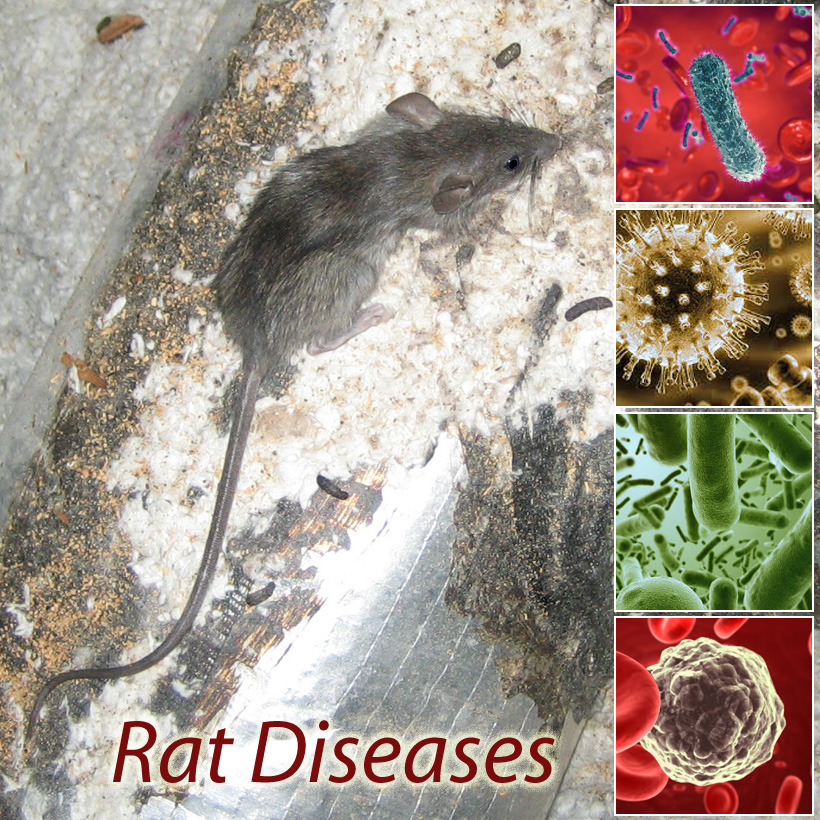- USA Wildlife Removal Education Guide and Resources
Rat Diseases Transmitted to Humans or Dogs

Rat Diseases - Rats are widely believed to be a species that is dirty and carriers of many diseases, and with so many plagues and diseases believed to have been transmitted by rats over the centuries, this belief does have some basis in truth. Today, it is still a smart precaution to avoid contact with rats, and not to eat any foods that have been contaminated by rat urine or feces, and the diseases that can be transmitted mean its still wise to deal with a rat problem promptly. Some of the conditions transmitted can be very serious, in some cases leading to fatal consequences, while others are little more than an inconvenience, causing little more than diarrhea and vomiting.
How Do Rats Transmit Disease?
There are several ways that rats can transmit diseases, and the most obvious method is when the victim is scratched or bitten by the animal, and for people who are scratched or bitten it is always best to seek medical advice. It is also possible to catch diseases from the feces of rats, when spores within that feces becomes disturbed by movement or being stepped on. The most difficult type of transmission to identify is through food contamination, as rat urine will often be invisible on food, and this means that people may still use that food or give it to their family, or in some cases pets, who can then contract diseases in that way.
Concerns For Diseases Transmitted From Rats To People
Many of the diseases that people can contract from rats can also affect other animals too, but one of the most dangerous conditions that people can catch is Hantavirus, which causes serious breathing problems and can be fatal. Rat-Bite Fever is another condition that is normally transmitted by a bite, which is also dangerous and has symptoms such as fever, chills and a range of aches and pains. Leptospirosis is another of the dangerous diseases that can be transmitted to people by rats, and largely affects those who are working in areas with rat feces and urine, with spores becoming airborne and causing lung problems that range from chills, fevers and rashes through to more serious issues such as liver damage, kidney failure and meningitis.
Zoonotic Diseases Passed From Rats To Other Animals
Leptospirosis can also be transmitted to dogs and other pets, while rat-bite fever is another condition that can affect animals and people alike. Tularemia is a threat to animals, and normally happens when pets eat rat carcasses infected with the condition, while it can also be transmitted by drinking water contaminated with rat urine or feces, with the symptoms including vomiting and diarrhea.
Rats And Rabies
This is one of the diseases that is not commonly transmitted by rats, although there are many people who do believe that rats can transmit the disease. Because rabies is passed to the victim by biting, rats will rarely survive an attack where they are bitten by a larger animal, meaning that if they do contract rabies they will usually be dead very soon after the attack. This means that examples of rabies being passed to people from rats are few and far between, and there are no confirmed rabies cases in the United States where the disease has been transmitted to people by a rat bite.
Rat Feces And Urine Contamination
This is one of the reasons that rats have been such a problem over the years, as the standard of construction and the nature of the way food was stored meant that rats could not only get to the foods stored by people in their pantries, but they could also easily contaminate the remaining food. This meant that the diseases passed through rat feces could easily be transmitted to an entire family, while contamination in a warehouse or storage area could see huge numbers of people affected. Today this type of contamination is less common, with most foods being stored appropriately, and the awareness of this type of transmission is greater, but it still does cause many diseases every year.
Dealing With A Rat Problem
The first thing to do if you have a rat problem is to identify where the rats are most active, and to focus your efforts on that area. There are a number of different precautions to take to make sure you don't catch any rat diseases, and that includes disposing of the carcasses properly, and making sure that you wear a breathing mask, goggles and thick long sleeved clothing to protect you when you are dealing with any area where the rats have been present. The traditional snap traps have been around for a very long time, but they are still the most effective way of dealing with a rat problem, and placing these in areas where you can see the signs of rat activity will usually show some good results.
Go back to the main Rat Removal page for more information about rat disease, and which ones humans can get, or pets such as cats or dogs.

